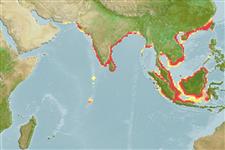Common names from other countries
Environment: milieu / climate zone / depth range / distribution range
Ökologie
seewasser; brackwasser; amphidrom (Ref. 51243); tiefenbereich 0 - 50 m (Ref. 189). Tropical; 27°N - 7°S, 61°E - 121°E (Ref. 189)
Indo-Pacific: coasts of Pakistan, India, Myanmar and south of Penang; apparently not yet found in Gulf of Oman nor in the Persian Gulf; Malaysia, Indonesia north to Taiwan, no records from Papua New Guinea or northern coasts of Australia.
Size / Gewicht / Alter
Maturity: Lm ? range ? - ? cm
Max length : 11.0 cm SL Männchen/unbestimmt; (Ref. 189)
Rückenflossenstacheln (insgesamt) : 0; Afterflossenstacheln: 0; Afterflossenweichstrahlen: 29 - 37. Belly with 21 to 24 keeled scutes from isthmus to anus. Maxilla very long, reaching at least halfway along pectoral fin and to pelvic fin base in adults; first supra-maxilla absent; lower jaw slender. gill rakers with serrae on the inner edge in distinct clumps. A dark blotch behind upper part of gill opening, sometimes joined to dark saddle on nape.
Coastal pelagic (Ref. 68964). Presumably schooling, mostly inshore and perhaps tolerating estuarine conditions. Feeds on diatoms when young and prawn larvae, copepods and cypris when larger. The number of museum specimens suggest that it is fairly common (but not in Bombay waters).
Life cycle and mating behavior
Maturities | Fortpflanzung | Spawnings | Egg(s) | Fecundities | Larven
Wongratana, T., T.A. Munroe and M. Nizinski, 1999. Order Clupeiformes. Engraulidae. Anchovies. p. 1698-1753. In K.E. Carpenter and V.H. Niem (eds.) FAO species identification guide for fishery purposes. The living marine resources of the WCP. Vol. 3. Batoid fishes, chimaeras and bony fishes part 1 (Elopidae to Linophrynidae). FAO, Rome. (Ref. 9822)
IUCN Rote Liste Status (Ref. 130435)
CITES (Ref. 128078)
Not Evaluated
Bedrohung für Menschen
Harmless
Nutzung durch Menschen
Fischereien: kommerziell
Tools
Zusatzinformationen
Download XML
Internet Quellen
Estimates based on models
Preferred temperature (Ref.
115969): 25 - 29.2, mean 28.6 (based on 716 cells).
Phylogenetic diversity index (Ref.
82804): PD
50 = 0.5000 [Uniqueness, from 0.5 = low to 2.0 = high].
Bayesian length-weight: a=0.00575 (0.00327 - 0.01012), b=3.16 (3.01 - 3.31), in cm Total Length, based on LWR estimates for this species & Genus-body shape (Ref.
93245).
Trophic level (Ref.
69278): 2.8 ±0.21 se; based on food items.
Widerstandsfähigkeit (Ref.
120179): hoch, Verdopplung der Population dauert weniger als 15 Monate. (Preliminary K or Fecundity.).
Fishing Vulnerability (Ref.
59153): Low vulnerability (10 of 100).
